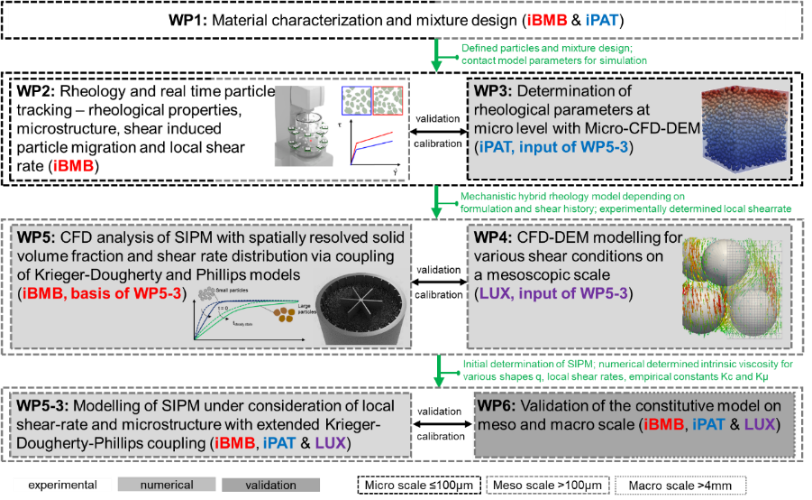19. From micro to macro – fundamental concrete modelling considering local shear rate and microstructure inhomogeneities due to processing using a scale-bridging approach
Principal investigator(s) – PI
- Dr.-Ing. Inka Mai (geb./b. Dreßler)
Technische Universität Braunschweig, Institut für Baustoffe, Massivbau und Brandschutz (iBMB), Fachgebiet Baustoffe - Dr.-Ing. Carsten Schilde
Technische Universität Braunschweig, Institut für Partikeltechnik (iPAT) - Prof. Dr. Bernhard Peters
University of Luxembourg, Institute of Computational Engineering
Researcher(s) in-charge – RI
- M.Sc. Mahmoud Eslami Pirharati
Technische Universität Braunschweig, Institut für Baustoffe, Massivbau und Brandschutz (iBMB), Fachgebiet Baustoffe - M.Sc. Dimitri Ivanov
Technische Universität Braunschweig, Institut für Partikeltechnik (iPAT) - M.Sc. Sina Hassanzadeh Saraei
University of Luxembourg, Institute of Computational Engineering
Subject Areas
Construction Material Sciences, Rheology of Cementitious Materials, CFD-DEM Simulations
Term
2021-2023
Project identifier
Deutsche Forschungsgemeinschaft (DFG) – Projekt Nummer 451942209
Project Description
During processing, e.g. pumping, casting or slip-forming, concrete flow behaviour is determined by the rheological properties of a) the bulk material and b) the interface layer near the wall. Hence, modelling the macroscopic flow behaviour of concrete or other cementitious suspensions during processing requires a clear description of the mechanisms forming the interface layer as well as of rheological properties of bulk and interface material. Therefore, the shear induced particle migration (SIPM) has to be taken into account as a dominating mechanism, with larger particles migrating from regions of high shear rates to regions of lower shear rates. Another key issue is upscaling from cement paste to mortar or concrete modelling. Nowadays, fundamental models based on chemical and physical particle interactions mostly exist for cement paste, whereas existing concrete rheology models are largely based on continuum mechanics or Discrete Element Method (DEM) and validated based on empirical data.
The goal of the present project is to investigate and model macroscopic concrete flow behaviour with regard to both, the influence of the interface layer at the wall and the particle interactions, being the key issues for fundamental modelling of concrete rheology. To consider the effect of particle interactions on the macro-scale rheological models, the problem of upscaling from cement paste to concrete level has to be solved in the first place. The rheology of cement paste highly depends on its microstructure, which is determined by the shear history and hydration effects. Hence, fundamental rheological models must consider effects on microstructure formation. However, shear rates acting on cement paste at concrete level are largely unknown. In fact, the real shear rate acting on cement paste at concrete level is significantly higher than the global, i.e. macroscopic, shear rate. This so called local shear rate acting on cement paste in concrete is determined by the particle packing (distance between larger particles, i.e. sand and gravel) and the relative velocity of two adjacent large particles. As (specifically) larger particles are subject to SIPM, leading to severe inhomogeneous particle distributions at the macro-scale, the local shear rates are also varying depending on the actual solid concentration and particle size distribution in a certain volume increment. Clearly, this inhomogeneity is more pronounced in the interface layer than in the bulk material. However, in many cases the bulk system has to be also considered as inhomogeneous, if differences in global shear rates over bulk volume are prevalent.
Therefore, the aim of the present project is the investigation and modelling of time- and shear-dependent microstructure (disperse properties) and rheological properties of cementitious sus-pensions subjected to shear. In this project, the addressed key issues are a) SIPM, b) interface layer and its formation mechanisms, c) local shear rates induced by larger particles and d) its effect on microstructure and rheology taking chemical and physical based particle-particle interactions into account. Only a scale-bridging approach from the micro-scale (dparticle < 100 μm) over the meso-scale (0.1 mm ≤ dparticle ≤ 4 mm) to the macro-scale (dparticle > 4 mm) enables to adequately achieve this goal. Here, suspensions relevant to the construction industry, i.e. containing super-plasticizer, are considered in this project.
In order to effectively address this complex issue within the proposed project, the work is divided into three main parts, following a bottom-up approach:
Micro-scale: Modelling the cement paste behaviour as a function of shear, time and mixture composition on the micro-scale in order to describe microstructure and rheological properties of cement paste. Hence, CFD-DEM simulations will be coupled with a genetic algorithm in order to derive a semi-mechanistic hybrid model, which will be supplied to meso-scale (WG Schilde).
Meso-scale: Determination of local shear rates and SIPM with special focus on the interface near the wall enabling quantification of exposure to cement paste and local suspension composition. To achieve this, high-resolution CFD-DEM simulations with the immersed boundary method will be applied (WG Peters).
Micro- to macro-scale: Results of the numerical simulations from WG Schilde and WG Peters will be up-scaled and homogenised respectively to an entire continuum modelling approach. In order to ensure large-scale applicability, SIPM, local shear rate, microstructure of cement paste and its effect on the macroscopic flow has to be taken into account. Hence, an iterative novel coupling of two models will be applied. Therefore, information about real particle flux, local shear rates, interface layer and microstructure, i.e. state of particle flocculation, will be gained with pioneering experiments in a rheometer and tribometer at micro- and meso-scale combined with simulations. Finally, the applicability of the model on the macro-scale will be proven to predict real construction processes in the future (WG Dressler).

